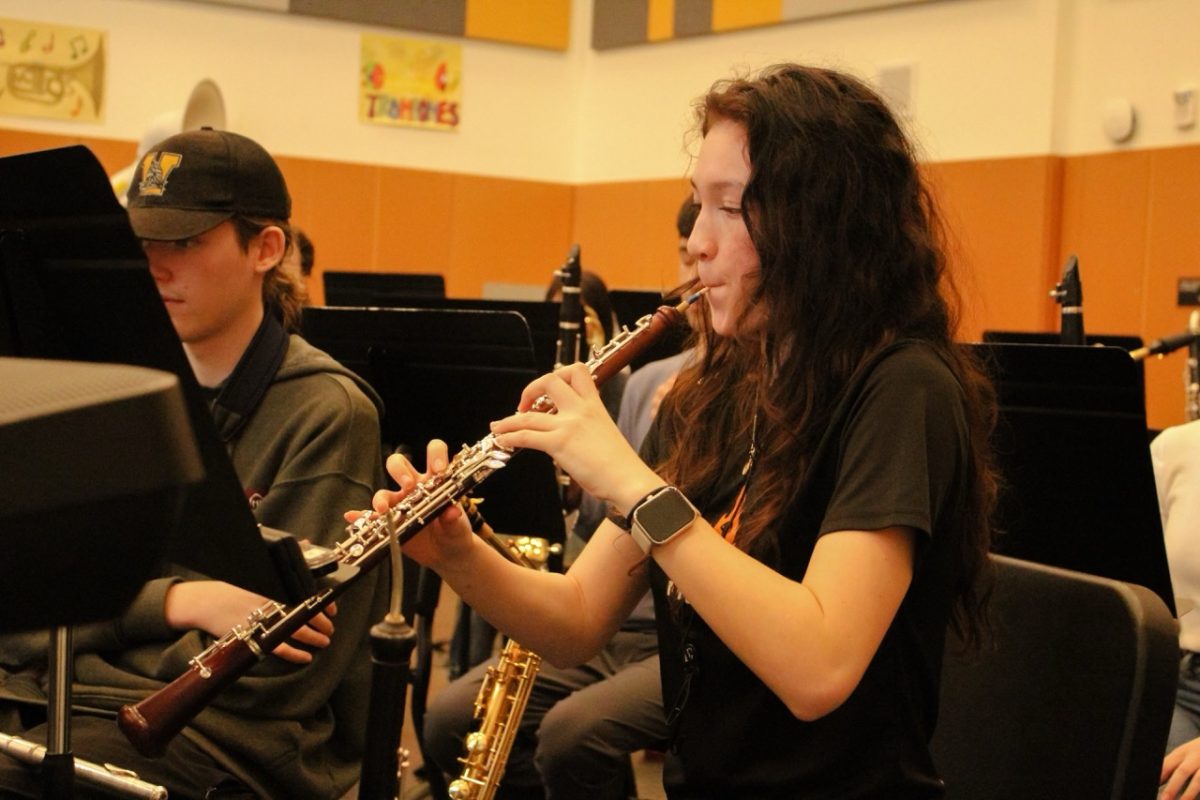Many different groups work in harmony to produce the music in the musical: actors must memorize lyrics and melodies; orchestral musicians must learn the scores and follow the actors; and the theatre technicians, or “techs,” must ensure that microphones are properly adjusted and the sound of the musical is mixed to perfection.
Theater techs collaborate to make the musical cohesive. Sound technicians use a technique called line-by-line mixing to amplify the actors’ voices. Each time an actor says something, they turn that actor’s microphone output volume up. When they’re not speaking, they turn it down.
“We also mix the pit to match the actor’s volume, so that way the actor is more prominent,” sophomore and sound/mic tech Luke Zeng (he/him) said. “We put the actors’ voices through a ton of effects, like a lot of EQ, and then also some reverb.”
The pit orchestra must fully adapt its performance to what the actors do on stage. Freshman and actor Ayaan Kohli (he/him) chimed in on the importance of sound technicians in making sure the cast follows the music accordingly.
“They play the song and we have to listen to our cues. If there’s a beat in the song, we have to hit that. If there’s a certain note, we have to hit that,” Kohli said. “So overall, they do a really good job at supporting you vocally, because they either take care of your voice or match the note.”
The orchestra also adjusts its music when lead actors may want to sing a piece differently than how it is written on the sheet music. For example, at the sitz-probe — the first rehearsal where the actors and pit meet to practice their music — musicians will annotate sheet music for the actors. Junior and pit instrumentalist Arya Bailey (she/her) spoke about her experience throughout this process.
“Depending on the context and how our specific theater department decides to do stuff, there can be changes, like, ‘Just don’t play that measure,’ or ‘Way quieter because we cannot hear the people on stage,’” Bailey said. “So there’s a lot of nuances.”
Bailey also said it takes a lot of effort to make the pit’s music appear to be in the background to the audience. There are musical measures that they repeat called “safety measures,” until the director Charlie Fix — who faces the stage — sees whatever action on stage that signals for them to pass on from the safety measure and continue onto the rest of the song. Mr. Fix cues the pit as well as the actors for things such as when to conclude a long note based off of cues on stage or sound cues from tech. Bailey noted how the pit’s music is supposed to feel like background music.
“I’m excited to hear the ensemble sing with us because it’s pretty on its own, but also, you can tell it’s background,” Bailey said. “Once you put all the lyrics and everything else together, it’s pretty epic.”
Senior and assorted percussionist Zane Rubenstein (he/him) noted that no play goes the exact same way, and that musicians have to think on their feet. Especially for pit instrumentalists who play multiple instruments, they have to switch quickly between instruments. Some nights things might go wrong. Rubenstein recalled how the pit had to adapt to a problem in the 2024 play.
“Last year during closing night of Mean Girls, all of the mics died right before a song, so we had to adjust to play super quietly so the audience could hear the song,” Rubenstein said.
Down in the pit, there’s not much to do while the orchestra isn’t playing, but Bailey said she was friends with the majority of the people on pit her last time and enjoyed laughing with them about each others’ mistakes. Bailey describes the pit orchestra as a great community and thoroughly enjoyed it the last time she participated.
“One of the cool things about pit is you get to know the actors that you’re working with, and you get to know the show,” Rubenstein said. “So by the time you get to the last couple nights of a run, it really feels like you’re just flowing with everybody else on stage, you know what you’re supposed to be doing when. It just feels really nice. You get to enjoy the show.”











